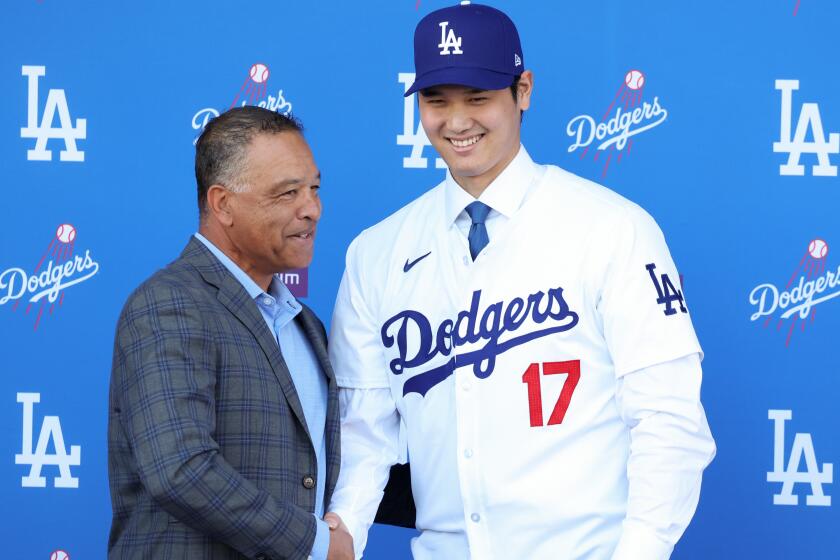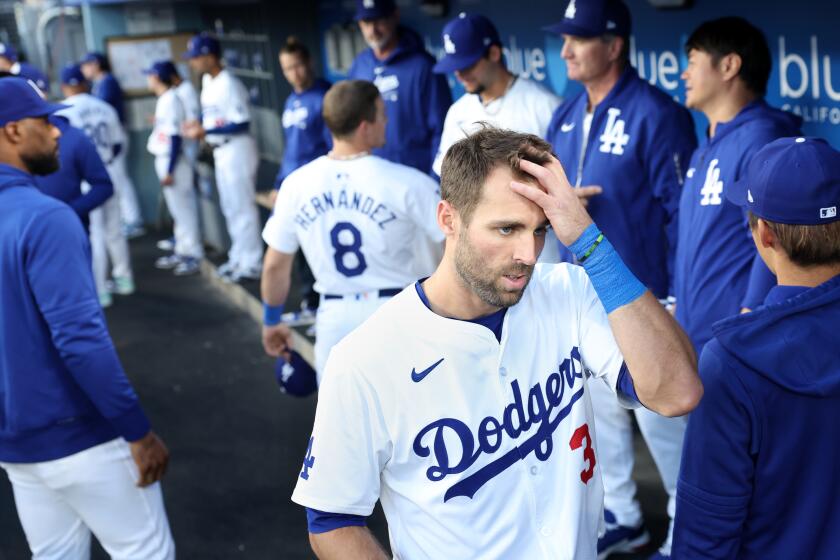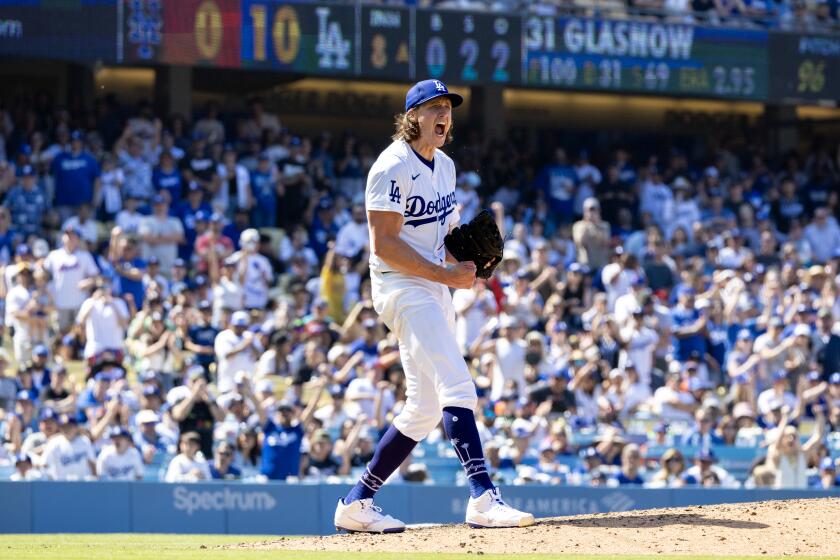Out at home
BROOKLYN, N.Y. -- A 24-story apartment building dominates the modest skyline near Prospect Park. With a security guard planted at one entrance, a metal fence encircling it and security doors to protect it, the structure looks like a fortress.
Only a sign in front informs residents that they are not living on just any old plot of earth. It reads: “EBA, Ebbets Field Apartment.”
But even this designation must fight for recognition against more recent, more poignant memories. A banner on a fire department facility just down the street reads: “We will never forget. Sept. 11, 2001.” On a building next to EBA are the likenesses of three New York City police officers killed in the line of duty. And just down the street is Medgar Evers College, named for the slain civil-rights figure.
Fifty years after the last roar shook Ebbets Field, only faint echoes remain of the Dodgers, the team that played in that storied ballpark for 45 seasons and served as the lifeblood of this borough.
And even those echoes often fall on deaf ears.
There are signs and plaques largely ignored by those who pass by them every day, a museum housing precious memorabilia of sometimes forgotten stars and the memories of a diminishing group of graying baby boomers who remember entering the hallowed ballpark on Bedford Avenue and Sullivan Place while tightly clenching their fathers’ hands.
“When Pee Wee Reese died,” said Marty Adler, who has spent years inducting Brooklyn Dodgers into a Hall of Fame he formed, “we tried to get a school named after him. But so many people didn’t know who the heck he was.”
Up on Montague Street in the financial district, a plaque on the side of a bank marks the spot where the Brooklyn Dodgers offices were located, the building where Jackie Robinson put his name on a Dodgers contract and his lasting imprint on the civil-rights movement. It reads: “Where the Dodgers made baseball history and Jackie Robinson changed America.”
In a noon-time crowd, no one gives it a second glance.
“When I walk through the streets of Bay Ridge,” said former Dodgers catcher Joe Pignatano of the Brooklyn community in which he lives, “half the people don’t even know who I am. That’s OK. I like it that way.”
The 78-year-old Pignatano is not one for sentiment, despite being a Brooklyn native. He caught the last five innings of the last game played at Ebbets Field half a century ago, yet, asked about it now, he says, “It was just another game.”
He took no souvenirs from the ball park that day, although he does admit to having one ball from each of the 17 years he played professional baseball.
“They’re up in the attic in a cardboard box,” he said. “I’ll leave it up to my grandson to put them out someday.”
Fortunately for those with more concern about the storied past, there are plenty of items on display at the Brooklyn Baseball Gallery, housed in KeySpan Park at Coney Island, where the Brooklyn Cyclones of the New York-Penn League, a Class-A affiliate of the New York Mets, have been playing since 2001.
There are old pictures, trading cards, uniforms and fistfuls of dirt and two seats from Ebbets Field. There is the glove of Mickey Owen, the catcher who will forever be remembered for dropping a third strike that cost the Dodgers a game in the 1941 World Series. There’s a Jackie Robinson bat and a Casey Stengel uniform.
And there is so much more celebrating a borough whose baseball roots go further back than Ebbets Field. Much further back. Ebbets Field was a state-of-the-art marvel of the modern age to the true pioneers of the game.
After all, it was in Brooklyn, that:
Baseball was being played as long ago as 1845.
There were 71 teams playing in the borough by the late 1850s.
Henry Chadwick wrote a rule book of the game and is credited with inventing the box score.
Arthur “Candy” Cummings is believed to have perfected the curveball and James Creighton threw the first changeup, according to the Brooklyn gallery.
The first documented trip was undertaken in 1860 by a Brooklyn squad that spent two weeks traveling through upstate New York.
The first enclosed baseball park was constructed in 1862. Named the Union Grounds, it was erected in Williamsburg and included one section for women and another for gamblers.
There were teams named the Mutuals, Eckfords, Atlantics, Excelsiors, Bridegrooms, Superbas and Trolley Dodgers. A plaque commemorating the Excelsiors, formed in the 1850s, still remains in Brooklyn Heights.
“Nowhere has the national game of baseball taken a firmer hold than in Brooklyn,” wrote a sportswriter in the Brooklyn Daily Eagle back in 1892.
Adler has done his best to maintain those memories with his Hall of Fame.
“Time is running out to remember these guys,” he said. “Every year, it seems another old Dodger dies.”
But for Joan Hodges, the 81-year-old widow of former Dodgers first baseman Gil Hodges, mother of four, grandmother of six and great-grandmother of four, it’s not all about the past.
“We don’t say the Brooklyn Dodgers. We just say Dodgers,” she explained from her Brooklyn home. “They will always have a special place in my heart. But I think it’s wonderful that baseball has come back with the Cyclones. I go to their games all the time.”
There is even a big-league revival looming in Brooklyn, even if it is a very different league. The New Jersey Nets of the NBA are planning to move from the Meadowlands to a planned arena in Brooklyn near Atlantic and Flatbush, on the very site Dodgers owner Walter O’Malley had hoped to build a domed stadium to keep his team in the borough.
“Loyalty to the Dodgers is perhaps the strongest emotion man can experience,” according to a 1941 Life magazine article.
But when those loyal fans were abandoned in 1957, despite the fact it was New York city commissioner Robert Moses rather than O’Malley who killed the stadium plan, bitterness against the team erupted.
And lingered for years.
“About 10 years ago,” said former Dodgers traveling secretary Billy DeLury, “I was standing in front of our dugout during batting practice at Shea Stadium. There was this kid about 19 years old who was just ripping into all our players as they were going up to home plate.
“Finally, I turned around and said to him, ‘Why do you hate the Dodgers so much?’
“ ‘Because,’ he said, ‘my father told me to hate them.’ ”
Not all of those echoes are pleasant sounds.
--
More to Read
Are you a true-blue fan?
Get our Dodgers Dugout newsletter for insights, news and much more.
You may occasionally receive promotional content from the Los Angeles Times.






